story and photographs by Gary Reich
Why buy another boat when you can refurbish the one you already own (and love)? Here are three boat owners who turned their existing boats into their dream boats.
What do you do when a perfectly functional and well-loved boat gets, well, out of date and (dare I say) shabby? For some, that means it’s time to buy a new one, fresh off the showroom floor, complete with all the razzle dazzle high techy stuff that boats ought to have these days, and built from spiffy new composites that are easy to clean and maintain. Oh, and a few feet longer. For others, it means rolling up their sleeves and getting to work, and there are plenty of folks doing just that.
I spent a month poking around a handful of Chesapeake Bay boatyards and boat shops and found everything from a couple who completely reimagined their 73-foot trawler, to an avid angler who changed the cockpit layout of his 56-foot express sportfish. I even found a 1978 wooden buyboat being restored from the keel up so its owner can cruise from the Chesapeake to the Bahamas.
No Holds Barred: Mr. Jim
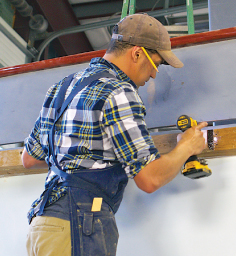
I visited the Campbell’s boatyard complexes in Oxford, Md., hunting for more common nuts-and-bolts projects like deck refinishing or an interior redo. I’d gathered a few stories there before on Campbell’s boatbuilding operation, so I knew there’d be something interesting going on.
Sure enough, at Campbell’s Bachelor Point facility an owner has taken a no-holds-barred approach to stripping a 35-year-old wooden powerboat and converting her into a stout, seaworthy cruising vessel. The boat is
Mr. Jim, a 51-foot Chesapeake-style oyster buyboat built in 1980 by Dorchester county boatbuilder Mr. Jim Richardson and used as a tour boat by the Chesapeake Bay Maritime Museum. Her current owner purchased her with the idea of fully restoring her and then outfitting her with a working-style interior.
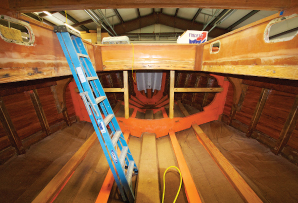 Mr. Jim
Mr. Jim was originally built as a replica, designed to match the lines and shape of traditional oyster buyboats that used to ply the Bay, buying oysters straight off a waterman’s boat and hauling them shoreside for processing. Only a handful of the vessels are left, many of them converted to cruising boats by enthusiastic owners who simply love the look and feel of these beefy, attractive boats.
Mr. Jim’s new owner is one such person.
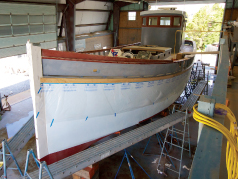
Andrew Abreu, owner of Abreu Boatworks in Trappe, Md., and his crew, has been hired to completely repair and restore her structure, from top to bottom, while Campbell’s Bachelor Point Yacht Company is taking on most of the mechanical, electrical and systems work. “There’s some original structure left, of course,” Abreu says, “but just about everything from stem to stern has been replaced and made better than original. That includes many frames, knees, the skeg and numerous other structural parts. The rest of the boat has been completely replanked using mahogany.” Now mahogany isn’t something you’ll find on many—if any—buyboats. This tropical hardwood is extremely tough and rot-resistant, but it’s also pretty pricey. The fact that the owner is using this material is a testimony to his dedication to doing this refit right.
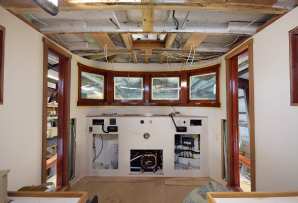
Inside
Mr. Jim, the original engine has been replaced with a modern, 300-hp Cummins turbo diesel engine with all-new running gear. Likewise, her electrical, plumbing and related engine-support systems have been completely replaced. Modern hatches have taken the place of the old leaky ones, and high-tech Garmin electronics are being slipped in place including radar, chartplotter, autopilot and more. Her interior hadn’t been addressed when I last visited, but yard owner Tommy Campbell tells me they plan to outfit her in a casual workboat style.
Mr. Jim’s owner will cruise her to the Bahamas when she is finished, later this year.
Please Put Your Seats in Their Full Upright and Locked Positions: Reel Estate
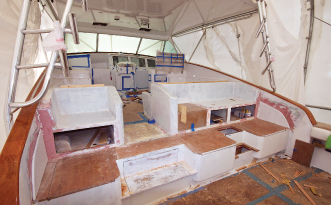
Wandering across Deltaville Boatyard in Deltaville, Va., is always an adventure. This is an outfit known for its custom work, and sure enough, I found another interesting project beneath the protective cover of a full custom tent.
Reel Estate, a 57-foot Jim Smith custom express sportfish yacht is getting a full cockpit and bridgedeck rehab, including a complete reorganization of her cockpit seating arrangement.
When she was built and launched in 2006,
Reel Estate had a cockpit setup similar to other sportfish yachts. Ahead of it and forward to starboard was a partial bulkhead with stowage compartments and a large rigging station used for prepping baits and stowing tackle. To port was more stowage, with a set of walk-through steps providing access to the bridgedeck.
Reel Estate’s owner wanted to add aft-facing seating in the cockpit, but without sacrificing the stowage and rigging station setup.
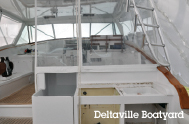
As an avid angler, I can attest to the benefits of more cockpit seating. When you’re trolling a spread of lures, for example, you need to monitor it or you may miss bites. Without ample cockpit seats, folks tend to move forward onto the bridgedeck or into the main saloon when they get tired of standing. This not only takes eyes off the troll, it also separates folks from the excitement of the bite. Aft-facing seats, especially, make the cockpit more hospitable for entertaining. Sounds easy, right?
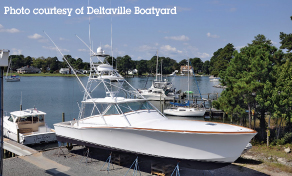
Not surprisingly, you can’t just go moving bulkheads without careful planning. What if the boat needs repowering at some point? On
Reel Estate pushing the cockpit seating forward into the bridgedeck potentially hindered access to the engines. To solve this problem, Deltaville Boatyard carpenters custom-fashioned sturdy seating modules that are permanent and robust, but installed in such a way that they can be removed fairly easily should the boat ever need a repower.
Now in place of the original starboard rigging station and port stowage units are aft-facing seats with clever stowage compartments set into the steps below them. A portion of the bridgedeck modification is jointed in a stealthy manner, so it can be removed later if necessary. Additionally, the entire bridgedeck and cockpit have been sanded, filled and prepped for a new coat of Awlgrip: a tough, glossy, two-part paint that will make it all look brand new.
While
Reel Estate’s changes are extensive, the modifications are certainly less expensive than finding a new boat—especially if you’re happy with everything else about the one you already own.
Making Better … Better: Retired Sailor III
The tale of
Retired Sailor III, a 73-foot Snowbird trawler, is all about customization, comfort, and making an already good thing better. Built in 2005 by Park Isle Marine in British Columbia, Canada, this stout vessel was commissioned by a couple who had extensive prior boating and cruising experience and who both put a lot of careful thought into the design and build of this large custom yacht. They had previously owned two Grand Banks trawlers and a handful of cruising sailboats, hence their current boat’s name.
These folks knew exactly what they wanted, based on their years of cruising experience: a comfortable cruising yacht for short jaunts as well as the perfect “mobile home” for their annual trips to the Bahamas. The Snowbird worked well, but after a few years, they wanted to make some changes and major upgrades. Experience had pointed them to Deltaville Boatyard (right there with Reel Estate) where I could see first-hand the amazing transformation they had in mind.
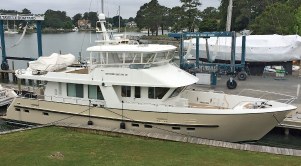
The Snowbird 73 was originally set up with diesel-electric propulsion, and while this is a very efficient and reliable way to power a boat (many modern cruise ships are actually diesel-electric powered), the owners were ultimately not satisfied with the performance the system provided.
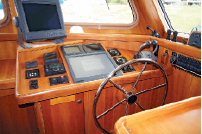
Repowering her with twin Yanmar 720-hp diesels was perhaps the biggest chunk of work done at the boatyard, but the engines are only part of the story, says project manager Sean Stuart, who added, “Replacing the engines is obviously a big job, but we also completely updated the engine room, adding all sorts of networked systems and monitoring equipment, touch-screen displays, fire-suppression gear, not to mention completely reworking all of her running gear, all the plumbing and other related systems.” To get the old system out and the new power plants in, Stuart’s crew had to cut a hole in the boat. No, I’m not joking.
“When you’ve got four big generators to remove and even bigger diesel engines to put back in, that’s what you do,” Stuart says. “We strategically cut a hole in the main saloon sole to facilitate removing the old diesel-electric machinery. Then once we’d readied the engine room for the new engines, we loaded each one up on a crane, squeezed it through the main saloon sliding doors, and then lowered it into the engine room, below.” Stuart tells me that the repower provided the performance the owners were looking for, and the power plants now have more than 2,000 reliable—and speedy—hours of service on them.
The repowering also provided the opportunity to install systems-monitoring technologies to enhance the owners’ ability to run the big boat and all its inherently complex mechanical systems. The system, made by Maretron, displays everything from engine room temperature, turbo boost pressure and coolant temperatures, to fuel and holding tank levels and battery voltages—and more. “There are touch-screens in the engine room, lower helm and on the flying bridge,” Stuart says. “Each has many different menus to keep the owners informed, which means they’re more comfortable running a boat with such complicated systems. It really seems to put their minds at ease.”
The completed engine room is a work of art, resembling a surgery theater more than a place where grease, oil and transmission fluids live. Everything is labeled, hoses are neatly and securely routed, and flat-screen displays show the status of everything that’s happening in real time. “Despite everything being so complex-looking, we’ve made it so the owners can really keep on top of everything themselves. Everything is easy to reach and service, and the owners even have a service by Wheelhouse Technologies that reminds them when items as minor as a water pump impeller need servicing,” Stuart says. They can cruise without having to wonder if they’ve forgotten to service something that could be about to fail.”
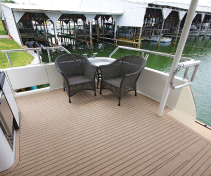
But replacing the propulsion system and upgrading the systems-monitoring gear weren’t the only projects the owners wanted to accomplish at Deltaville Boatyard. The original deck, a “faux teak” material made of high-density plastic, looked great, but it ultimately turned out to be too hot for bare feet, especially under the intense Bahamian sun. While some vestiges of that decking material remain in areas where the deck is shaded (on the flybridge, for example), the rest of the decks were stripped bare and replaced with a cooler, easier-on-the-feet material made of cork. It doesn’t look like teak, but I can attest to how nice it feels underfoot. “It’s a much better alternative than what was there originally,” says Stuart, “and it’s also a decent choice for anyone who has an old boat that needs new decks. It’s much less expensive than solid teak and comes without the constant upkeep.”
Inside
Retired Sailor III are all sorts of other clever upgrades, such as dimmable LED lights, which are extremely efficient and produce very little heat—important in the tropics. But the real showstopper on this boat is something you’d never expect to find on a boat of any sort: Pull down a neatly concealed panel under a set of galley cabinets and press a rocker switch. Like magic, a custom fabricated, powder-coated aluminum basket drops from the cabinet, guided by a set of Harken mainsheet traveler cars that you’d normally find on a sailboat.
“What the heck is that?” I asked Brian Ankrom, a customer liaison at the yard.
“It’s a dumbwaiter for lifting sandwiches and snacks up to the flying bridge, what do you think it is?” he chuckled, adding, “You can cook meals or simple lunches down here and send them right up to the flybridge to whoever is driving the boat. It’s also great for entertaining and happy-hour celebrations. Despite all the work we’ve done to this boat to make it better, the electric dumbwaiter is the one addition people ‘Oooh and ahhh’ at the most.”
Go figure.
So, what’s the lesson to be learned from all of this? Just because you don’t like a certain aspect of your boat—or if it’s getting long in the tooth—it doesn’t mean you need to sell it and start from scratch. Depending on your resources, there are plenty of things you can do to enhance your pride and joy, even if you don’t go whole hog as the owners of these boats have done. Just refinishing the cabin brightwork can make a huge difference in your boat’s “dockside appeal.” As plenty of boatowners can attest, anything you do to upgrade your boat is sweat well spent.
[ August 2015 Issue]